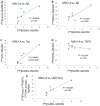Comparison of Monoamine Oxidase-A, Aβ Plaques, Tau, and Translocator Protein Levels in Postmortem Human Alzheimer's Disease Brain
- PMID: 37445985
- PMCID: PMC10341404
- DOI: 10.3390/ijms241310808
Comparison of Monoamine Oxidase-A, Aβ Plaques, Tau, and Translocator Protein Levels in Postmortem Human Alzheimer's Disease Brain
Abstract
Increased monoamine oxidase-A (MAO-A) activity in Alzheimer's disease (AD) may be detrimental to the point of neurodegeneration. To assess MAO-A activity in AD, we compared four biomarkers, Aβ plaques, tau, translocator protein (TSPO), and MAO-A in postmortem AD. Radiotracers were [18F]FAZIN3 for MAO-A, [18F]flotaza and [125I]IBETA for Aβ plaques, [124/125I]IPPI for tau, and [18F]FEPPA for TSPO imaging. Brain sections of the anterior cingulate (AC; gray matter GM) and corpus callosum (CC; white matter WM) from cognitively normal control (CN, n = 6) and AD (n = 6) subjects were imaged using autoradiography and immunostaining. Using competition with clorgyline and (R)-deprenyl, the binding of [18F]FAZIN3 was confirmed to be selective to MAO-A levels in the AD brain sections. Increases in MAO-A, Aβ plaque, tau, and TSPO activity were found in the AD brains compared to the control brains. The [18F]FAZIN3 ratio in AD GM versus CN GM was 2.80, suggesting a 180% increase in MAO-A activity. Using GM-to-WM ratios of AD versus CN, a >50% increase in MAO-A activity was observed (AD/CN = 1.58). Linear positive correlations of [18F]FAZIN3 with [18F]flotaza, [125I]IBETA, and [125I]IPPI were measured and suggested an increase in MAO-A activity with increases in Aβ plaques and tau activity. Our results support the finding that MAO-A activity is elevated in the anterior cingulate cortex in AD and thus may provide a new biomarker for AD in this brain region.
Keywords: Alzheimer’s disease; Aβ plaques; [125I]IPPI; [18F]FEPPA; [18F]flotaza; [18]FAZIN3; human tau; monoamine oxidase-A.
Conflict of interest statement
The authors declare no conflict of interest. The funders had no role in the design of the study; in the collection, analyses, or interpretation of data; in the writing of the manuscript; or in the decision to publish the results.
Figures







Similar articles
-
[125I]IPPI for Tau Imaging: Binding Studies in Postmortem Human Alzheimer's Disease Hippocampus-Subiculum and Evaluation of Drug Effects.Synapse. 2025 Jul;79(4):e70024. doi: 10.1002/syn.70024. Synapse. 2025. PMID: 40619690 Free PMC article.
-
Development and evaluation of [125 I]IPPI for Tau imaging in postmortem human Alzheimer's disease brain.Synapse. 2021 Jan;75(1):e22183. doi: 10.1002/syn.22183. Epub 2020 Aug 6. Synapse. 2021. PMID: 32722889 Free PMC article.
-
Measurement of Aβ Amyloid Plaques and Tau Protein in Postmortem Human Alzheimer's Disease Brain by Autoradiography Using [18F]Flotaza, [125I]IBETA, [124/125I]IPPI and Immunohistochemistry Analysis Using QuPath.Biomedicines. 2023 Mar 27;11(4):1033. doi: 10.3390/biomedicines11041033. Biomedicines. 2023. PMID: 37189652 Free PMC article.
-
[Development of SPECT Probes for In Vivo Imaging of β-Amyloid and Tau Aggregates in the Alzheimer's Disease Brain].Yakugaku Zasshi. 2017;137(11):1361-1365. doi: 10.1248/yakushi.17-00156. Yakugaku Zasshi. 2017. PMID: 29093372 Review. Japanese.
-
[Imaging of neuropathology by PET tracers].Nihon Yakurigaku Zasshi. 2022;157(6):453-457. doi: 10.1254/fpj.22061. Nihon Yakurigaku Zasshi. 2022. PMID: 36328560 Review. Japanese.
Cited by
-
Ferulago angulata Extract Protects against Beta-amyloid-induced Memory Impairment Through Modulation of Monoaminoxidase Enzymes in the Rat's Hippocampus.Neurochem Res. 2025 Mar 5;50(2):114. doi: 10.1007/s11064-025-04365-3. Neurochem Res. 2025. PMID: 40042687
-
Reduction in [18F]Nifene Binding, a PET imaging Probe for α4β2* Nicotinic acetylcholinergic receptors in Hippocampus-Subiculum of postmortem human Alzheimer's disease brain.Brain Res. 2025 Jun 15;1857:149600. doi: 10.1016/j.brainres.2025.149600. Epub 2025 Mar 26. Brain Res. 2025. PMID: 40154862 Free PMC article.
-
[18F]Flotaza for Aβ Plaque Diagnostic Imaging: Evaluation in Postmortem Human Alzheimer's Disease Brain Hippocampus and PET/CT Imaging in 5xFAD Transgenic Mice.Int J Mol Sci. 2024 Jul 18;25(14):7890. doi: 10.3390/ijms25147890. Int J Mol Sci. 2024. PMID: 39063132 Free PMC article.
-
Biotin Mitigates Alcohol Withdrawal-Induced Anxiety and Depression by Regulating Serotonin Metabolism, BDNF, Inflammation, and Oxidative Stress in Rats.Neuropsychopharmacol Rep. 2025 Mar;45(1):e12523. doi: 10.1002/npr2.12523. Neuropsychopharmacol Rep. 2025. PMID: 39754400 Free PMC article.
-
Towards Imaging Tau Hyperphosphorylation: Is DYRK1A a Potential Target for Imaging Hyperphosphorylation of Tau? Molecular Modeling Assessment and Synthesis of [125I]Radioiodinated DYRK1A Inhibitor.Molecules. 2025 Feb 21;30(5):990. doi: 10.3390/molecules30050990. Molecules. 2025. PMID: 40076215 Free PMC article.
References
-
- Patterson C. World Alzheimer Report 2018: The State of the Art of Dementia Research: New Frontiers. Alzheimer’s Disease International (ADI); London, UK: 2018.
-
- Mendez P.C., Surace E., Bérgamo Y., Calandri I., Vázquez S., Sevlever G., Allegri R.F. Biomarkers for Alzheimers disease. Where we stand and where we are headed. Medicina. 2019;79:546–551. - PubMed
-
- Thijssen E.H., La Joie R., Wolf A., Strom A., Wang P., Iaccarino L., Bourakova V., Cobigo Y., Heuer H., Spina S., et al. Diagnostic value of plasma phosphorylated tau181 in Alzheimer’s disease and frontotemporal lobar degeneration. Nat. Med. 2020;26:387–397. doi: 10.1038/s41591-020-0762-2. - DOI - PMC - PubMed

